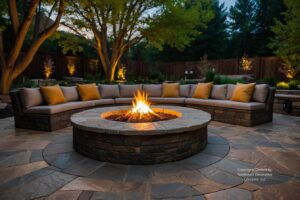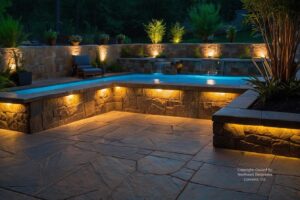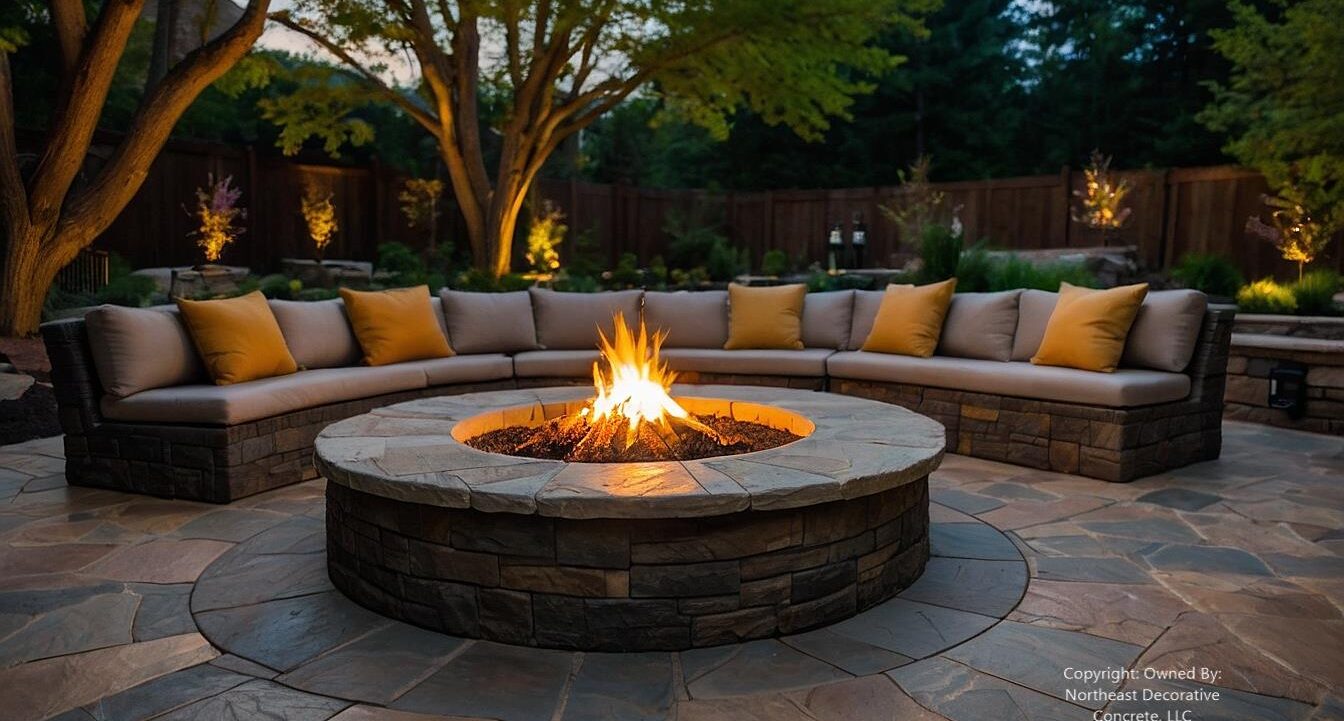
Restaurant Patio Designs for Stamped Concrete Eateries
Imagine a cozy restaurant in Nashua, New Hampshire. Guests enjoy local craft beers under string lights on a cobblestone patio. The secret? It’s not real stone—it’s stamped concrete. For Granite State restaurants, colored textured concrete decks are game changers. They are durable and have a stunning design. They survive harsh winters and turn outdoor spaces into profit-boosting attractions.
This guide will explore why pigmented concrete dominates New Hampshire’s restaurant balcony scene. You’ll get tips, examples, and expert advice. They will help you build a terrace to impress customers and endure New England weather.
Key Takeaways
-
Mix patterns for unique themes.
-
Use pigment to influence dining behavior.
-
Embed branding into the floors.
-
Heat outdoor patios for year-round use.
-
Seal properly to reduce maintenance.
Textured concrete turns floors into a restaurant’s silent salesperson. Creative designs keep guests coming and cash registers ringing, whether at a cozy Granite State pub or a lakeside café.

Why Stamped Concrete Works for Restaurants
New Hampshire’s freeze-thaw cycles and snowy winters wreck traditional balcony materials. Customized cement solves this with a 25+ year lifespan. Here’s why it’s a top pick:
| Feature | Stamped Concrete | Brick Pavers | Natural Stone |
|---|---|---|---|
| Cost per sq. ft. | $10–$20 | $15–$30 | $20–$50 |
| Winter Durability | High | Moderate | Low (cracks easily) |
| Maintenance | Low (reseal every 3 to 5 yrs) | High (weeds, shifting) | Moderate (re-grouting) |
| Customization Options | 50+ patterns/colors | Limited styles | Limited supply |
Key Takeaway: Imprinted concrete pads are better than pavers and stone. They’re cheaper, more durable, and more flexible in design—important for Granite State’s climate.
Sky Meadow Country Club (Nashua, NH)
Sky Meadow transformed a bland terrace into a 6,800 sq. ft. stained cement masterpiece.
-
Design: Ashlar slate pattern with a heated fire pit and automatic shutters for winter.
-
Result: 40% increase in outdoor dining revenue.
-
Pro Tip: “Always add slip-resistant additives to sealer for pool and dining areas,” says the owner of Northeast Decorative Concrete.
Stamped Concrete Design Ideas for Eateries
1. Rustic Cobblestone Charm
Mimic Portsmouth’s historic streets with European fan or New England patterns. Perfect for breweries and pubs.
-
Color combo: Gunmetal gray base + charcoal accents.
-
Case Study: A local restaurant in Manchester experienced a 25% increase in Instagram check-ins after adding a cobblestone-style kitchen balcony.
2. “Fake Wood Finish” Warmth
Wood-look cement adds cabin vibes without rot or termites.
-
Top pattern: Timber plank with walnut stain.
-
Pro Tip: Use a matte sealer to avoid a “plastic” look.
3. Modern Geometric Flair
Appeal to upscale crowds with sleek designs:
-
Hexagon tiles: are gray slate with white grout lines.
-
Bold borders: Contrasting tints frame seating areas.
4. New England Stone Farmhouse
Granite or fieldstone natural patterns pair with a white sealer for a farmhouse aesthetic.
-
Ideal for: Farm-to-table spots like The Local Harvest in Concord.
5. Commercial Concrete Non-Slip Poolside Patios
Restaurants with pools (NH has them!) use surface stone patterns and Gator Grip sealant.

Creative Decorative Concrete Solutions for Restaurants
Patterned concrete isn’t just durable—it’s a design powerhouse for restaurants. Granite State eateries, from rustic pubs to modern bistros, use dyed surface cement, which improves ambiance, boosts safety, and increases profits.
1. Themed Patterns That Tell a Story
Textured concrete mimics high-end materials at a fraction of the cost. Restaurants can match their theme:
| Theme | Textured Pattern | Example |
|---|---|---|
| Rustic Tavern | Cobblestone, Weathered Wood | The Old Mill Pub (Nashua) used European Fan for a 1700s vibe |
| Coastal Eatery | Shell Imprints, Driftwood | Seabreeze Grill (Portsmouth) added seashell prints near outdoor seating |
| Modern Bistro | Geometric Tiles, Sleek Slate | Urban Plate (Manchester) paired hexagon patterns with metallic epoxy accents |
Pro Tip: Blend patterns! The River’s Edge Café mixed Ashlar Slate with wood-look borders for a “mountain lodge” feel.
2. Color Psychology on a Plate
Pigments influence dining behavior. Concrete contractor pigments let restaurants set the mood:
-
Warm Reds/Oranges: Stimulate appetite (ideal for pizza joints).
-
Cool Blues/Greys: Create calm (perfect for seafood spots).
-
Earth Tones: Enhance farm-to-table authenticity.
Case Study: The Local Harvest (Concord) used a Fieldstone pattern in moss green and tan. Result: 18% longer table stays.
3. Branded Floors & Logos
Embed your logo or signature tints into walkways or bar floors:
-
How: Use custom patterns or stencils during pouring.
-
Example: A Manchester brewery textured its hop-leaf logo into the entryway, boosting Instagram tags by 30%.
Cost: Custom designs cost $3–$5 per sq. ft. extra, compared to $20–$50 per sq. ft. for an engraved stone.
4. Safe, Slip-Resistant Concrete Floor Surfaces
Granite State winters demand bright finishes. Popular options:
-
Poolside Patios: Surface Stone + Non-Slip Sealant (Gator Grip).
-
Entryways: Exposed aggregate for traction.
-
Bars: Matte finishes to prevent glass slippage.
Sky Meadow Country Club reduced winter slips by 60% using heated, cement-colored surfaces.
5. Outdoor Manchester New Hampshire Dining Magic
Transform terraces into revenue drivers:
-
Heated Concrete: Extend seasons (install $10–$15/sq. ft. heating cables).
-
Fire Pit Zones: Circle-textured patterns around custom fireplaces.
-
Lighting Integration: Embed LED strips into imprinted borders.
Stats: Restaurants with designed balconies see 25–40% higher summer sales.
6. Concrete Patio Wayfinding Designs
Guide guests subliminally:
-
Use contrasting hues to highlight:
-
Hostess stations
-
Restroom paths
-
Outdoor seating
-
-
Example: A Portsmouth eatery used herringbone-patterned “arrows” to direct flow, cutting servers’ steps by 20%.
7. Budget-Friendly “Fakeouts”
Fool the eye, not the wallet:
-
Faux Wood Decking: Timber Plank imprints + walnut stain (1/3 the cost of real wood).
-
Marble Illusions: Polished white surfaces with gray veining.
-
Brick Without the Mess: Old Chicago pattern + rust-red dye.
Durability: Ornamental concrete lasts 2–3 times longer than pavers in freeze-thaw cycles.
8. Low-Maintenance Commercial Patio Marketing
A concrete contractor’s terrace is a photo backdrop.
-
Hashtag Hotspots: Create Instagrammable corners (e.g., floral-imprinted sections).
-
Seasonal Themes: Re-stamp holiday sections (pumpkin patterns in the fall).
Pro Tip: Apply UV-resistant coatings, such as Brickform Ultra-Clear. This helps to keep stains bright.
Final Thoughts
A Colored balcony isn’t just flooring—it’s your restaurant’s new marketing tool. Use Sky Meadow’s success as a guide. Create a design. It should reflect your brand, endure nor’easters, and inspire guests to take photos. Ready to transform your Granite State eatery? To start your retail surface journey, partner with local experts. Try Northeast Decorative Concrete!
Our concrete walkways and sundeck areas pay for themselves every summer. Guests stay longer, order more, and rave about the ‘Tuscany vibes.’
Frequently Asked Questions:
Q: Will textured concrete crack under heavy terrace traffic?”
A” No. Properly installed colored concrete handles 500+ lbs/sq. Ft.—ideal for outdoor dining crowds. Add fiber mesh reinforcement for high-traffic zones like bars or entryways.
Q: How quickly can I reopen my balcony after installation?”
A: Most projects cure in 7 days for foot traffic. Work with contractors like Northeast Decorative Concrete. They offer weekend pours to minimize downtime.
Q: Can imprinted surfaces look upscale for fine-dining venues?”
A: Absolutely. Use polished finishes with metallic epoxy accents or mimic marble or terrazzo. The Urban Plate (Portsmouth) paired geometric patterns with gold leaf for a luxe vibe.
Q: How do I prevent winter damage to my restaurant terrace?
-
Use heated concrete ($10–$15/sq. ft. extra) to melt snow.
-
Seal with Brickform’s Arctic Grade Sealer (withstands -30°F).
-
Avoid salt—opt for (CMA) ice melts.
Our Locations:
Nashua, NH
North Hampton, NH
Concord, NH

